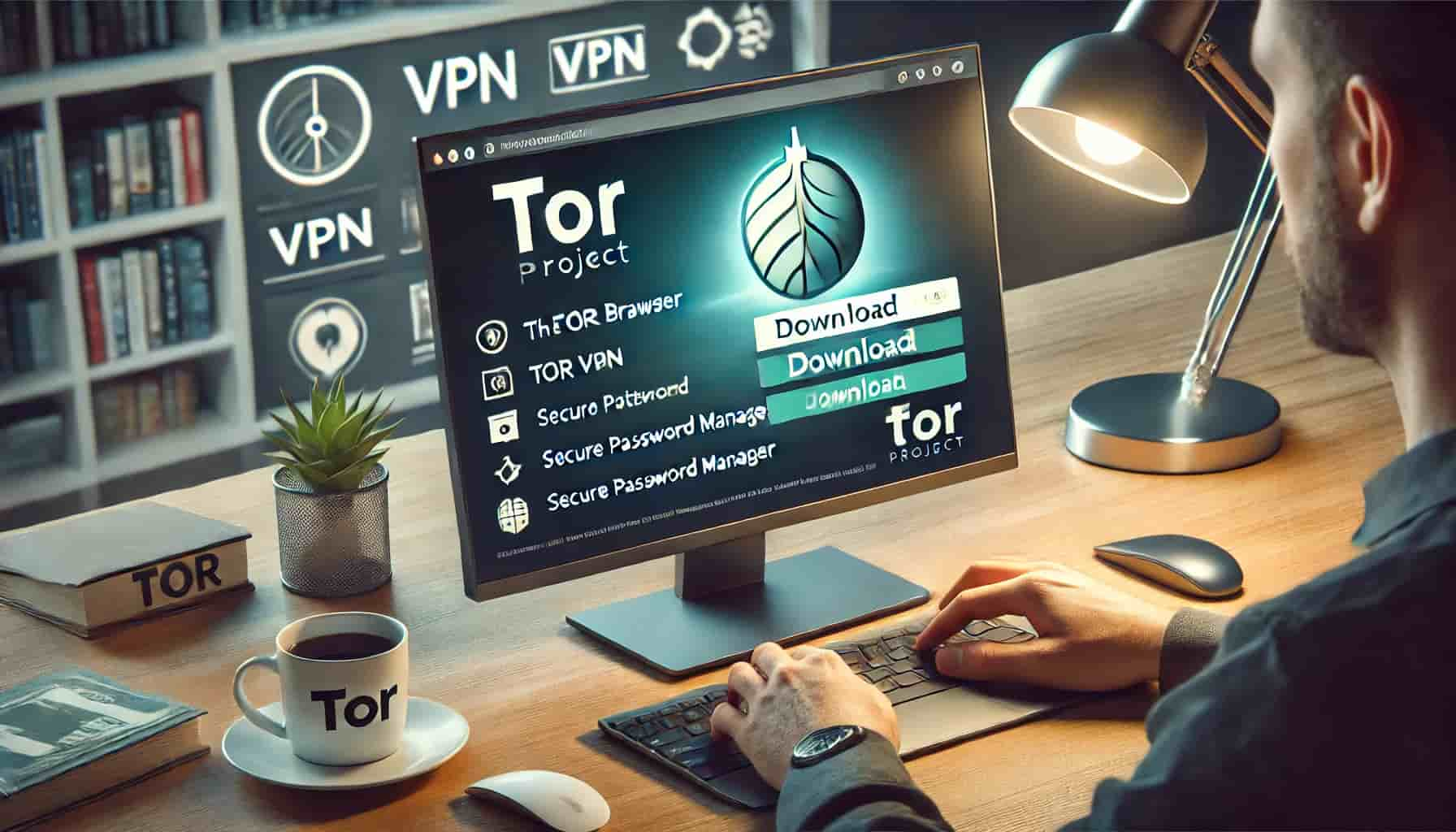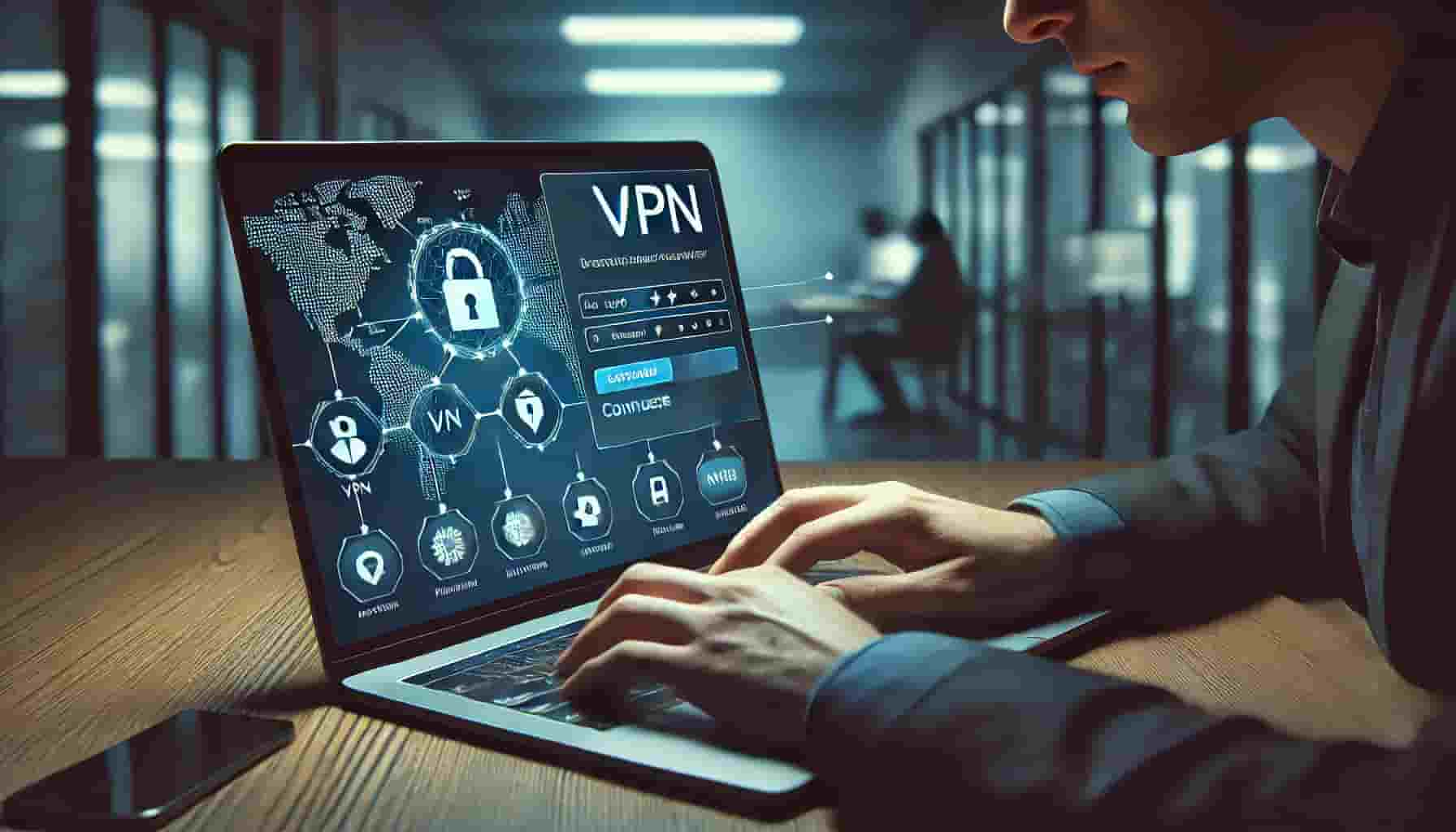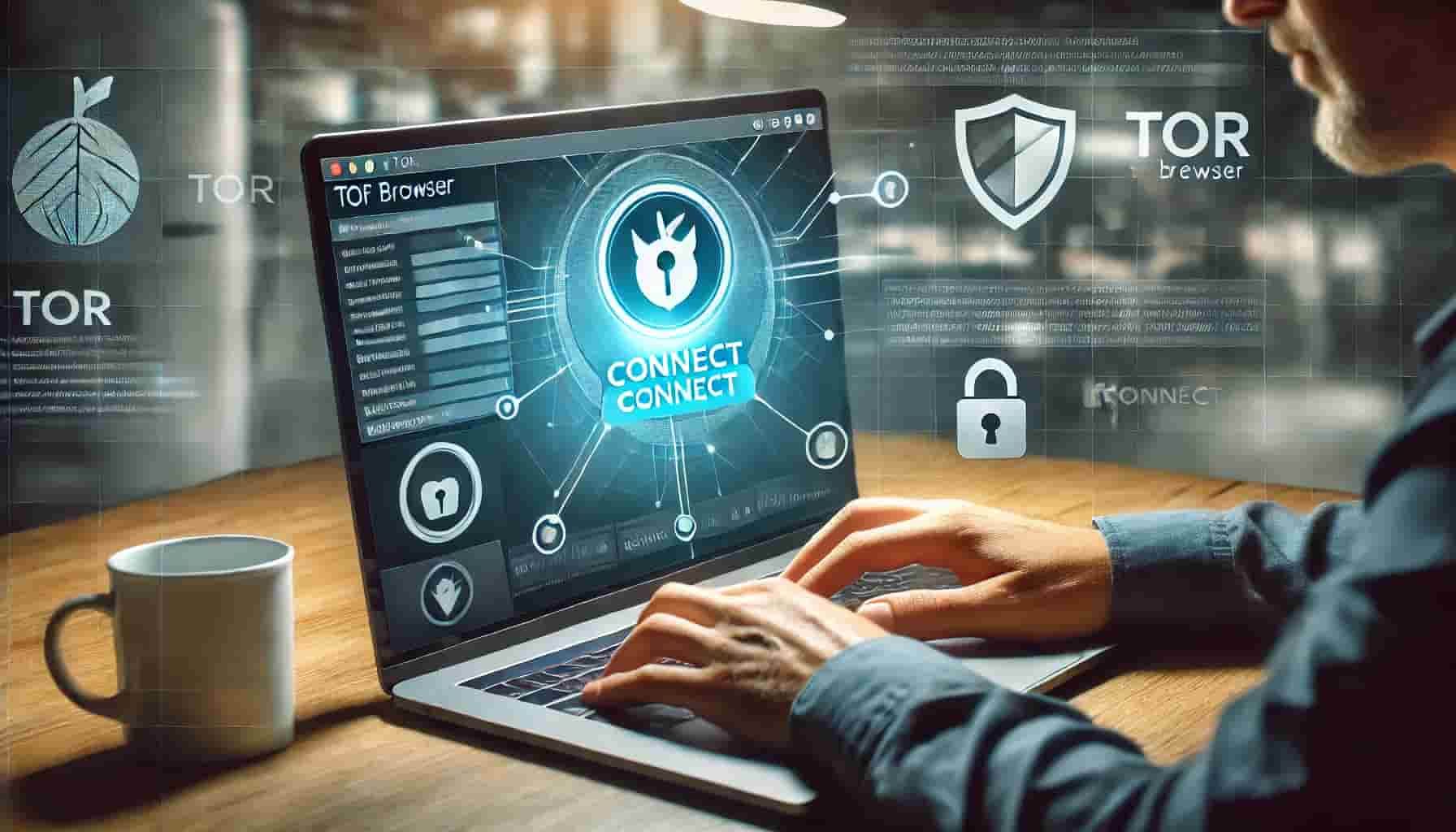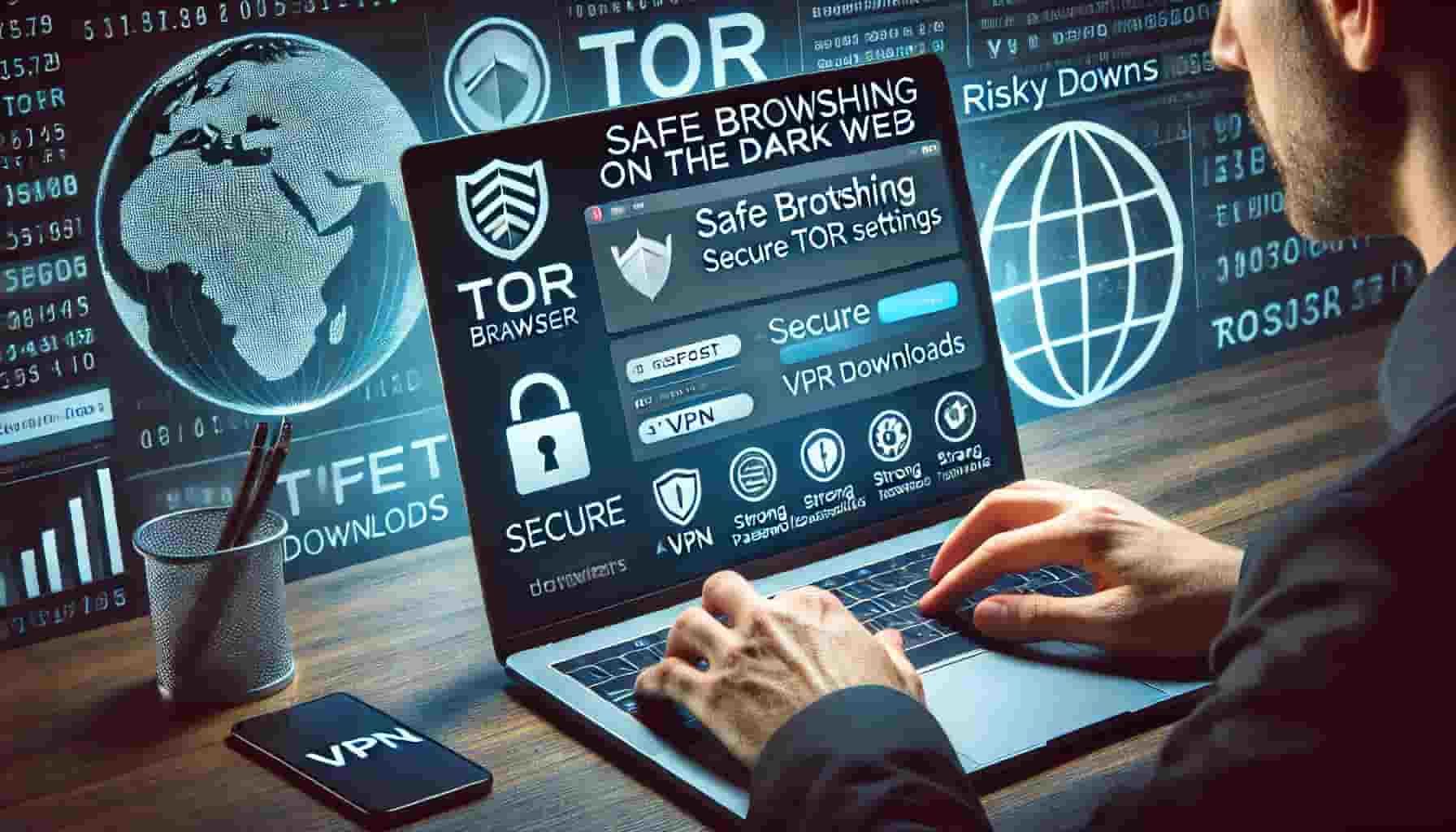The dark web has always sparked curiosity and fear alike. It’s a hidden corner of the internet that isn’t indexed by search engines like Google or Bing. Accessible only through special tools like Tor (The Onion Router), it offers anonymity and privacy beyond the capabilities of the regular web. But before diving in, it’s critical to know what you’re dealing with—and more importantly, how to connect to the dark web safely and anonymously.
While some people use it for legitimate purposes—like communicating under oppressive regimes or exploring uncensored forums—others are drawn by its mysterious, often dangerous reputation. Illegal marketplaces, hacking communities, whistleblower platforms—these all exist in the dark web’s shadows.
But connecting to it without proper precautions can be risky. Think identity theft, viruses, law enforcement surveillance—you name it. That’s why this guide walks you step-by-step through everything you need to know: from tools you need, to safety tips, and what to expect once you’re in.
Step-by-Step Guide to Accessing the Dark Web
If you’re wondering how to connect to the dark web without exposing your identity or device to unnecessary risk, following a secure process is key. Here’s a step-by-step breakdown for beginners to enter the dark web safely and anonymously:
Necessary Tools for Dark Web Access
To safely explore the dark web, you’ll need more than just curiosity. Equipping yourself with the right set of tools is essential to minimize risks and maximize anonymity. Here are the must-have tools for anyone learning how to connect to the dark web:
VPN (Virtual Private Network)
Before doing anything, activate a trusted VPN. A VPN acts as your first layer of protection, masking your IP address and encrypting your internet traffic. This prevents your ISP or potential hackers from tracking your activity.
Recommended VPNs for dark web use:
- ProtonVPN – Privacy-focused, open-source, and supports Tor over VPN
- NordVPN – Fast servers and a strict no-logs policy
Choose a VPN provider that doesn’t log data and supports strong encryption.
Tor Browser
The Tor Browser is your main gateway to access .onion websites on the dark web. It’s based on Mozilla Firefox but routes traffic through the Tor network, anonymizing your digital footprint.
Download only from the official Tor Project website.
Tails OS (Optional but Recommended)
Tails (The Amnesic Incognito Live System) is a live Linux-based operating system designed for privacy and anonymity. It runs from a USB stick and leaves no traces on the machine once powered off.
Using Tails with Tor and a VPN provides a triple layer of protection.
Secure Email & Alias Generator
If you need to sign up on dark web forums or marketplaces:
- Use encrypted, anonymous email providers like ProtonMail
- Generate random usernames and strong passwords using tools like Bitwarden
Never use your real name or regular email.
Cryptocurrency Wallet
Some dark web platforms require payment via Bitcoin or Monero. If so:
- Set up a private crypto wallet (never use exchange wallets)
- Use privacy coins like Monero (XMR) for better anonymity
Always clean your crypto through mixers if anonymity is critical.
Equipping yourself with these tools before connecting ensures you’re better prepared and less vulnerable. Each layer—VPN, Tor, secure OS—works together to shield your identity while exploring hidden web content.
Downloading and Installing the Tor Browser
One of the most crucial steps in learning how to connect to the dark web is downloading and installing the Tor Browser, your primary tool for accessing .onion sites anonymously. Tor stands for “The Onion Router,” and it works by bouncing your internet connection through a global network of relays, concealing your identity and location.

Here’s how to safely and correctly install it:
Step 1: Visit the Official Tor Project Website
Never trust third-party websites when downloading Tor, as they may offer tampered or malicious versions.
Go to: https://www.torproject.org
Step 2: Choose Your Operating System
The Tor Project supports multiple platforms:
- Windows
- macOS
- Linux
- Android
For extra security, consider using Tails OS, which comes with Tor pre-installed and doesn’t leave traces on your computer.
Step 3: Download the Installer
Click the appropriate download link for your system. Your browser may warn you that the file is from an unknown publisher—this is normal. Just ensure you downloaded it from the official Tor website.
Step 4: Verify the Download (Optional but Recommended)
For maximum safety, verify the file’s signature using the PGP key provided on the Tor website. This ensures that the installer hasn’t been tampered with or replaced by malicious software.
Step 5: Install the Browser
Run the installer and follow the prompts. Once installed:
- Launch the Tor Browser
- Choose “Connect” to link to the Tor network
- Optionally, configure it to route traffic through a bridge (useful in countries with internet censorship)
Step 6: Adjust Security Settings
After launching Tor:
- Click the shield icon (top-right corner)
- Set security level to “Safest”
- Disable JavaScript (some sites might break, but you gain protection from exploits)
Installing the Tor Browser from a trusted source and configuring it correctly is a vital part of any guide on how to connect to the dark web. Done right, it’s your safest path into the hidden corners of the internet.
Setting Up a VPN for Enhanced Security
When learning how to connect to the dark web, using a VPN (Virtual Private Network) is crucial for maintaining anonymity and protecting your identity. A VPN masks your real IP address and encrypts your online traffic, ensuring that your activity on the dark web remains private.

Here’s how to set up a VPN for the best possible protection:
Step 1: Choose a Reliable VPN Provider
Not all VPNs are created equal. For dark web browsing, it’s important to select a provider that prioritizes security, privacy, and doesn’t keep logs of your activity.
Top VPNs for dark web access:
- ProtonVPN – Offers strong encryption and a no-log policy
- NordVPN – Provides Double VPN technology for extra privacy
- ExpressVPN – Fast speeds and strong encryption protocols
Look for a VPN with military-grade encryption, no-logs policies, and servers in privacy-friendly jurisdictions.
Step 2: Download and Install the VPN
After selecting a VPN, go to the provider’s official website and download the appropriate version for your device (Windows, macOS, Android, iOS).
Once the download is complete:
- Open the installer
- Follow the on-screen instructions
- Launch the app and log in with your account details
Step 3: Connect to a Secure Server
To ensure your online activity remains anonymous, select a VPN server located in a privacy-friendly country. For extra protection, choose a server that offers Double VPN or onion over VPN features, if available.
This will route your traffic through both a VPN server and the Tor network for maximum security when accessing the dark web.
Step 4: Enable Kill Switch (Optional)
Many VPNs offer a kill switch feature. This automatically disconnects your internet if the VPN connection drops, ensuring you don’t accidentally expose your real IP address. Enable this feature for added security.
Step 5: Verify Your IP Address
Before connecting to the dark web, it’s important to verify that your VPN is working properly. Visit a site like WhatIsMyIP.com to check that your IP address is masked by the VPN. If your real IP is visible, disconnect and troubleshoot the VPN connection.
By setting up a VPN correctly, you add an extra layer of security to your dark web activities. It’s your first line of defense against tracking, surveillance, and cyber threats.
Configuring Tor Settings for Optimal Use
Once you’ve downloaded and installed the Tor Browser, configuring it properly is essential for how to connect to the dark web safely. By adjusting Tor’s settings, you can enhance your privacy, security, and overall browsing experience.
Here’s how to configure Tor for optimal use:
Step 1: Access the Tor Security Settings
When you open the Tor Browser for the first time, click on the shield icon next to the URL bar. This is where you can set the security level to adjust how Tor operates on your device.
Step 2: Set Security to “Safest”
For maximum security, set the security level to “Safest”. This option disables JavaScript, which can sometimes be used by malicious websites to exploit vulnerabilities in your browser.
- Go to Security Settings
- Choose “Safest” (the highest security setting)
While this might break some websites, it ensures you’re as protected as possible.
Step 3: Disable JavaScript for Added Protection
In addition to setting the security to “Safest,” you should also ensure that JavaScript is disabled for better anonymity. This is a key feature to protect you from malicious scripts often found on the dark web.
To disable JavaScript:
- Open Tor Browser
- Go to the Preferences or Settings menu
- Under the Privacy and Security section, check the box to disable JavaScript
Step 4: Use a Bridge if Tor is Blocked
In some countries, access to the Tor network is restricted or blocked. If you’re in such an area, you can use Tor bridges to bypass censorship.
- Go to Tor Browser settings
- Choose the Bridges tab and request a bridge from Tor’s website or your VPN provider
- Add the bridge information into Tor’s configuration settings
Bridges route your traffic through unlisted entry points, helping you evade detection.
Step 5: Clear Your Browsing History
Always clear your browsing history and data after each session to ensure your activity isn’t traced. Tor automatically clears some of this data, but it’s a good habit to manually delete it as well.
Go to Preferences > Privacy & Security, and check that:
- Clear history when Tor Browser closes is enabled
- Always use private browsing mode
Step 6: Avoid Logging into Personal Accounts
When exploring the dark web, avoid logging into personal accounts like email or social media. This could expose your identity or link your activities on the dark web to your real identity. Always browse anonymously and use aliases if needed.
By configuring Tor with these settings, you significantly enhance your security and anonymity while exploring the dark web, ensuring a safer browsing experience.
Establishing a Safe Connection to the Tor Network
When learning how to connect to the dark web, one of the most crucial steps is ensuring you’re establishing a safe connection to the Tor network. This ensures your traffic is routed securely and anonymously, protecting your identity from prying eyes.

Here’s how to establish a secure and private connection to the Tor network:
Step 1: Launch the Tor Browser
First, open the Tor Browser on your device. If you haven’t already, ensure that you’ve set up a VPN and have adjusted your Tor settings for maximum privacy (as covered in the previous sections).
Step 2: Click “Connect” to Join the Network
When you open Tor for the first time, you’ll be prompted with a screen asking if you want to “Connect” or “Configure”.
- Click “Connect” to quickly join the Tor network
- If you’re in a country where Tor is blocked, click “Configure” and set up a bridge or a pluggable transport (explained in the previous section)
Step 3: Wait for the Connection to Establish
After clicking “Connect”, Tor will begin to establish a connection to the network. It may take a few moments, depending on your internet speed. During this time, Tor will connect you to its volunteer relay nodes, which will route your traffic through multiple layers of encryption for anonymity.
Step 4: Verify Connection Anonymity
Once Tor is connected, it’s essential to verify that your connection is anonymous and safe. To do this:
- Open WhatIsMyIP.com or a similar IP-checking website
- Ensure that the IP address shown is not your real one, but instead a random Tor exit node IP
If your real IP is visible, it indicates that Tor may not be connected properly or that your VPN is not working as intended.
Step 5: Disconnect and Reconnect if Issues Arise
If you notice any connection problems or suspect that your traffic is being monitored, disconnect from the Tor network and reconnect. This can refresh your route and ensure that your browsing remains anonymous.
Step 6: Maintain a Secure Connection During Browsing
While browsing on the dark web, it’s crucial to ensure that your Tor connection stays secure. Avoid using your regular internet connection for any other activity while connected to Tor, and be cautious of pop-ups or downloads that might compromise your privacy.
By following these steps, you’ll ensure that your connection to the Tor network remains secure, allowing you to safely explore the dark web while protecting your privacy.
Navigating the Dark Web: Using .onion URLs
Once you’ve set up Tor and established a secure connection, it’s time to start browsing the dark web. However, how to connect to the dark web involves more than just opening the Tor Browser. You’ll need to know how to navigate using .onion URLs, the unique domain names used exclusively on the Tor network.

Here’s everything you need to know about .onion URLs and how to safely navigate the dark web:
What Are .onion URLs?
.onion is a special top-level domain (TLD) used exclusively within the Tor network. These addresses are not accessible through regular browsers like Chrome or Firefox; they are hidden and can only be reached through the Tor Browser. .onion sites are often used for privacy-focused platforms, forums, or even illegal activities.
Step 1: Understand the Structure of .onion URLs
A typical .onion URL looks like this:
These addresses are randomly generated, making them difficult to guess or remember. They’re
designed this way to protect the anonymity of both website owners and visitors.
Step 2: Access .onion Websites
To access a .onion site, simply enter the URL into the Tor Browser’s address bar. For example:
If the site is accessible, Tor will connect you to it via its secure network, and the page will load as normal.
Step 3: Use Dark Web Directories for Safe Navigation
Finding .onion URLs can be tricky since they aren’t indexed by standard search engines. To explore the dark web safely, use trusted dark web directories that list .onion websites. Some well-known directories include:
- The Hidden Wiki – A popular directory of .onion links
- OnionDir – A categorized list of .onion websites
Always use caution when clicking on links from these directories, as some may lead to malicious sites.
Step 4: Stay Cautious of Suspicious Sites
While navigating the dark web, you might encounter harmful sites or links that could infect your device with malware. Here are a few tips to stay safe:
- Avoid downloading files from unknown sites
- Never provide personal information or log in to your regular accounts
- Use VPN and Tor’s highest security settings for added protection
Step 5: Bookmark Trusted Sites
If you find .onion sites that you trust, consider bookmarking them for easier access. Since .onion URLs are long and difficult to remember, saving them ensures you can quickly return to sites you’ve previously visited.
Navigating the dark web with .onion URLs is a straightforward process once you understand the structure and safety precautions. Remember to always stay cautious, use secure methods of browsing, and verify the legitimacy of the websites you visit.
Recommended Dark Web Directories and Search Engines
When you’re learning how to connect to the dark web, one of the challenges is finding reliable sources for .onion URLs. Unlike the surface web, where search engines like Google provide results, the dark web requires specialized directories and search engines that index .onion sites.
Here are some recommended tools to help you navigate the dark web safely and efficiently:
The Hidden Wiki
The Hidden Wiki is one of the most well-known and trusted dark web directories. It offers a categorized list of .onion links, including marketplaces, forums, and privacy-focused tools.
- Pros:
- Categorized listings
- Includes popular and verified .onion sites
- Regularly updated
- Cons:
- Some links may lead to unreliable or unsafe websites
- Can contain adult or illegal content (be cautious)
OnionDir
OnionDir is another directory that categorizes .onion sites. It’s known for its clean and organized layout, making it easy to find sites related to privacy, education, and technology. OnionDir is frequently updated and gives users access to many different types of content.
- Pros:
- Neat, organized layout
- Offers a range of categories like technology, news, and more
- Reliable and frequently updated
- Cons:
- Can include links to risky websites (always use caution)
DuckDuckGo on Tor
DuckDuckGo is a privacy-focused search engine that can be accessed on the dark web via DuckDuckGo’s Tor URL: https://3g2upl4pq6kufc4m.onion/. It works like its surface web counterpart, offering anonymous searching without tracking your activity.
- Pros:
- Simple, clean, and effective search engine
- Privacy-focused, no tracking
- Access to dark web-specific results
- Cons:
- Limited to dark web results only (no surface web links)
NotEvil
NotEvil is a dark web search engine similar to Google. It’s known for providing an indexed list of .onion sites, including forums, marketplaces, and much more. NotEvil has a reputation for its speed and accuracy, but users should be cautious about the content they encounter.
- Pros:
- Fast and comprehensive search results
- Includes a variety of content (technology, forums, etc.)
- Cons:
- Some links might lead to harmful or illegal content
Ahmia
Ahmia is a privacy-focused search engine for the Tor network. It provides access to indexed .onion sites and filters out illegal or harmful content, making it a safer option for newcomers.
- Pros:
- Filters out illegal content
- User-friendly interface
- Comprehensive results
- Cons:
- Doesn’t include as many sites as other search engines like NotEvil
Safety Tips When Using Dark Web Directories and Search Engines
- Verify the legitimacy of links before clicking
- Avoid downloading files from untrusted sites
- Check the URL to ensure you’re on a legitimate .onion website
- Use a VPN and Tor’s highest security settings at all times
These directories and search engines make it easier to find what you need on the dark web, but always prioritize your privacy and safety when browsing.
Best Practices for Safe Browsing on the Dark Web
While exploring the dark web can offer great anonymity and privacy, it also comes with significant risks. To stay safe and ensure that your activity remains private, it’s crucial to follow best practices for secure browsing. Here are key guidelines on how to connect to the dark web safely and avoid potential pitfalls.

Always Use a VPN
One of the most important steps in safe dark web browsing is using a VPN (Virtual Private Network). A VPN encrypts your internet connection and masks your real IP address, adding an extra layer of protection when you access the Tor network.
- Why it’s important: It prevents your ISP, government agencies, or hackers from tracking your online activity.
- Recommended VPNs: ProtonVPN, NordVPN, or ExpressVPN
Enable Tor’s Highest Security Settings
For maximum protection while browsing, set Tor’s security level to “Safest”. This disables features like JavaScript and certain media elements, which are commonly exploited by malicious websites.
- How to enable: Click the shield icon in the Tor Browser and select the highest security setting. This limits your exposure to potentially harmful scripts.
Avoid Logging into Personal Accounts
Never use your personal credentials (like email or social media accounts) while on the dark web. Doing so could potentially tie your dark web activities to your real-world identity, compromising your privacy.
- What to do instead: Use disposable email accounts or aliases to sign up for forums or services.
Don’t Download Files from Untrusted Sources
Malicious files are a significant threat on the dark web. Never download files from unknown sources, as they could contain viruses, ransomware, or other harmful software.
- Tip: If you must download files, consider using a virtual machine (VM) or sandbox environment to contain potential threats.
Double-Check .onion URLs
Unlike the surface web, the dark web uses .onion domains that are randomly generated and not indexed by regular search engines. Always double-check the .onion URLs you visit, especially if they come from directories or search engines.
- How to stay safe: Bookmark trusted .onion sites and avoid clicking on random links from directories that might lead to dangerous content.
Use Strong Passwords and Two-Factor Authentication (2FA)
If you need to create accounts on the dark web, ensure your passwords are strong and unique. Consider using a password manager to generate and store secure passwords. Additionally, enable two-factor authentication (2FA) on any account that supports it.
- Why it matters: Strong passwords and 2FA add an additional layer of protection in case your account information is compromised.
Keep Your System and Tor Browser Updated
To protect yourself from new vulnerabilities, always keep both your Tor Browser and your operating system up to date. Security patches are regularly released to fix flaws that could be exploited by attackers.
- Tip: Enable automatic updates for Tor to ensure you’re using the latest, most secure version.
Be Wary of Scams and Phishing Attempts
Scammers are active on the dark web, often trying to trick users into revealing personal information or sending money for fake services. Always remain cautious and question the legitimacy of what you encounter.
- What to do: Avoid financial transactions unless absolutely necessary, and never provide sensitive data like banking information.
By following these best practices, you can significantly reduce the risks associated with browsing the dark web and enjoy a safer, more private experience.
Legal Considerations While Accessing the Dark Web
When exploring the dark web, it’s important to understand the legal implications and responsibilities that come with accessing this hidden part of the internet. While using the Tor network and .onion websites itself is not illegal, how to connect to the dark web involves navigating potential legal risks if you engage in illegal activities or access prohibited content.
Here are the key legal considerations to keep in mind when browsing the dark web:
Accessing the Dark Web Is Not Illegal
Simply connecting to the dark web through the Tor Browser is not against the law. The dark web itself is a tool that provides privacy and anonymity. Many people use it for legitimate purposes, such as:
- Protecting their identity in oppressive regimes
- Engaging in political activism
- Communicating privately with journalists or whistleblowers
As long as you’re accessing public, non-illegal sites, your presence on the dark web does not break any laws.
Engaging in Illegal Activities Is Illegal
While the dark web offers a lot of privacy, it also harbors illegal content. Engaging in or accessing illegal activities such as:
- Buying or selling illegal goods (e.g., drugs, firearms, stolen data)
- Hacking services
- Engaging in illegal pornography
is against the law. In many countries, law enforcement actively monitors the dark web, and engaging in these activities could lead to criminal charges.
Using Privacy Tools to Protect Yourself Is Legal
Using VPNs, Tor, and encryption tools to protect your identity and communication is legal in most countries. These tools are widely used by journalists, activists, and citizens seeking privacy. However, it’s important to note that using these tools with the intent of committing a crime could lead to legal consequences.
- Tip: Always ensure that your actions align with local laws, even if you are using privacy tools.
Know the Laws in Your Country
Laws vary significantly depending on your location. In some countries, simply using the Tor network or accessing certain dark web sites may be restricted or illegal. Before browsing the dark web, familiarize yourself with your local laws regarding internet usage and privacy.
For example, countries like China and Iran actively block access to the Tor network, while other countries may have laws about data encryption or online privacy.
Keep An Eye on Digital Forensics
Law enforcement agencies are becoming increasingly skilled at monitoring dark web activity and identifying users. Digital forensics tools can track and identify individuals who participate in illegal dark web activities, even when using encryption or anonymizing networks.
To minimize the risk of getting caught:
- Don’t engage in illegal activities
- Always follow security best practices, such as using a VPN, Tails OS, and keeping your system up to date.
Risk of Malicious Activity
While not illegal, browsing the dark web can expose you to various risks. Scams, phishing attempts, and malware are common on .onion websites. Accessing these sites can lead to:
- Malware infections
- Phishing scams
- Fraudulent activities
To avoid falling victim to these risks, don’t click on suspicious links or download files from untrusted sources.
By being aware of these legal considerations and adhering to best practices, you can browse the dark web safely while avoiding illegal activity. Always prioritize your privacy, security, and legal safety.
Alternatives to Tor for Dark Web Access
While the Tor Browser is the most commonly used tool for accessing the dark web, there are alternative methods available for users who wish to explore the dark web securely and anonymously. Knowing these alternatives can be helpful for those seeking more options in how to connect to the dark web.
Here are the most notable alternatives to Tor:
I2P (Invisible Internet Project)
I2P is an alternative anonymity network to Tor, designed specifically for anonymous communication. Unlike Tor, which is primarily used for accessing hidden websites, I2P is optimized for peer-to-peer (P2P) communication, offering secure, encrypted messages between users.
- How it works: I2P encrypts and routes your internet traffic through multiple layers of encryption, similar to Tor, but focuses more on secure communications rather than web browsing.
- Pros:
- Great for secure email and file-sharing
- A robust, decentralized network
- Cons:
- Slower than Tor for browsing websites
- Not as widely adopted or supported as Tor
If you are looking for secure communication rather than traditional dark web browsing, I2P is a strong option.
Freenet
Freenet is another anonymity-focused network that allows users to share files, browse .onion-like sites, and chat securely. Like I2P, Freenet provides a decentralized network with encrypted traffic, but its focus is more on creating a censorship-resistant space.
- How it works: Freenet routes traffic over a distributed network of computers, ensuring that your browsing and communication are encrypted and difficult to trace.
- Pros:
- Excellent for file sharing and forum-based communication
- Completely decentralized
- Supports darknet sites
- Cons:
- Slower than Tor for web browsing
- Limited content available compared to Tor’s .onion network
Freenet is ideal for those interested in creating a censorship-free internet, though it may not be as user-friendly as Tor for web browsing.
I2P-Bote (I2P’s Secure Email System)
I2P-Bote is an anonymous email service built on the I2P network, providing encrypted communication between users. While it’s not directly an alternative for browsing .onion sites, it’s an option for those wishing to engage in anonymous, encrypted communication while using the dark web.
- How it works: Uses I2P to send encrypted messages, providing privacy for users who don’t want to use traditional email systems.
- Pros:
- Highly secure email solution for the dark web
- Anonymity in communication
- Cons:
- Not suitable for general web browsing
- Less user-friendly compared to other services like ProtonMail
If email privacy is your primary concern, I2P-Bote is a great tool for anonymous communication on the dark web.
Zeronet
Zeronet is a decentralized web platform that uses Bitcoin and bitmessage to achieve its goal of anonymity. Unlike Tor, Zeronet operates without the need for an anonymity network to browse websites. Instead, it relies on peer-to-peer (P2P) technology to host and serve websites securely.
- How it works: Zeronet uses P2P to distribute and host websites, making it highly decentralized. The content is served through encrypted peer networks, ensuring that you remain anonymous while browsing.
- Pros:
- Fast compared to Tor and I2P
- More robust in hosting static content
- Good for decentralized applications (dApps)
- Cons:
- Fewer sites available compared to Tor’s .onion
- Not ideal for browsing dynamic websites
If you’re interested in exploring decentralized websites and apps while maintaining privacy, Zeronet can be a suitable alternative to Tor.
VPN with Dark Web Access
For those looking to access dark web content without using Tor, a VPN with dark web access can offer an alternative method for maintaining anonymity. While VPNs alone don’t offer the same level of encryption as Tor, they can still provide privacy when combined with other tools.
- How it works: A VPN will encrypt your internet traffic and mask your IP address. Some VPN services also offer onion over VPN features for accessing dark web sites.
- Pros:
- Easy to use with no additional software (just a VPN app)
- Works for any browser, not just Tor
- Cons:
- Does not provide the same level of anonymity as Tor
- Trust is required in the VPN provider
If you’re primarily concerned about IP masking rather than total anonymity, using a VPN may be sufficient for accessing .onion sites.
Choosing the Right Alternative for Your Needs
While Tor is the most popular and well-known tool for accessing the dark web, alternatives like I2P, Freenet, Zeronet, and others provide different types of anonymity, privacy, and network characteristics. The best option depends on your specific needs:
- For secure, encrypted communications: Try I2P or Freenet
- For decentralized applications: Zeronet might be your best choice
- For general dark web browsing: Stick with Tor unless you’re looking for an alternative privacy setup
FAQs: How to Connect to the Dark Web
Is it safe to connect to the dark web?
Yes, it is safe to connect to the dark web if you take proper precautions. Using tools like Tor, a VPN, and enabling security settings like “Safest” mode in Tor Browser can significantly enhance your security and privacy. However, you should avoid engaging in illegal activities, downloading unknown files, or visiting suspicious websites.
How do I connect to the dark web anonymously?
To connect to the dark web anonymously, follow these steps:
- Install Tor Browser from the official website.
- Use a VPN to mask your IP address.
- Configure Tor’s security settings to the highest level.
- Avoid logging into personal accounts or revealing personal information.
- Use encrypted communication tools like I2P or Freenet if necessary.
These steps ensure you maintain a high level of anonymity while browsing the dark web.
Can I access the dark web without Tor?
Yes, there are alternatives to Tor for accessing the dark web. I2P, Freenet, and Zeronet are other privacy-focused networks that offer secure browsing options. However, Tor is the most widely used tool, and it provides the strongest anonymity features compared to others.
Is using Tor legal?
Using Tor is legal in most countries. Tor Browser is simply a tool for anonymous browsing. However, accessing illegal content or engaging in criminal activities on the dark web is illegal and can result in serious consequences. It’s crucial to remain within the boundaries of the law while using Tor or any other dark web access tool.
What is a .onion website, and how do I access it?
A .onion website is a special domain that can only be accessed through the Tor Browser. These sites provide increased privacy and security and are used for a variety of purposes, from forums to file-sharing. To access .onion sites, simply enter the .onion URL in the Tor Browser’s address bar.
Can I get hacked on the dark web?
While the dark web offers anonymity, it also poses risks. Malicious actors on the dark web may attempt to scam you, steal your information, or infect your device with malware. To protect yourself, always use a VPN, ensure Tor’s highest security settings are enabled, avoid downloading files from unknown sources, and be cautious when clicking links.
What tools do I need to access the dark web?
To access the dark web, you will need:
- Tor Browser – for secure access to .onion sites
- VPN – to protect your IP address and encrypt traffic
- A secure email provider (like ProtonMail) for anonymous communication
- Strong passwords and encryption tools for privacy
- Optional: I2P or Freenet for alternative access methods
The dark web can be an incredibly powerful tool for those seeking privacy, anonymity, or access to information not available on the surface web. By following the proper steps and best practices for securing your connection, you can explore this hidden side of the internet safely.
Remember, how to connect to the dark web involves more than just installing Tor and browsing .onion sites. It requires vigilance, caution, and the use of essential privacy tools like VPNs, secure email services, and the highest security settings in Tor. By respecting legal boundaries and avoiding risky behaviors, you can ensure that your experience remains both safe and anonymous.
If you’re concerned about your personal information being exposed on the dark web, it’s essential to take steps to remove it. Learn how to protect your privacy and get your information off the dark web in our comprehensive guide for 2025.
For detailed instructions, check out How to Get My Information Off the Dark Web (2025 Edition).




